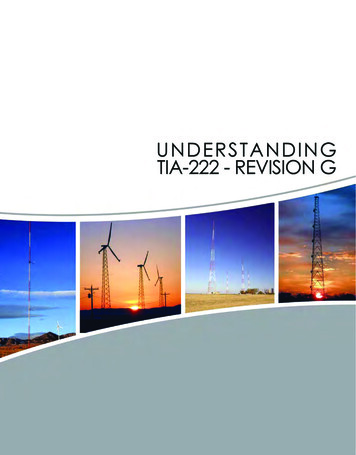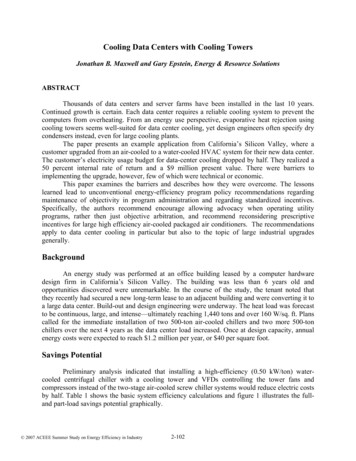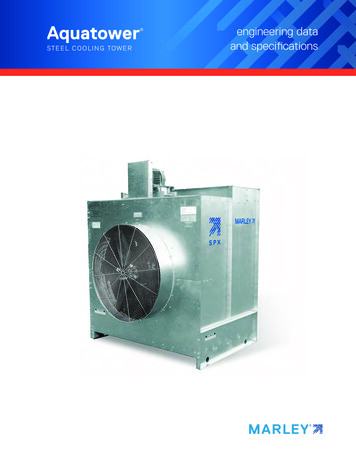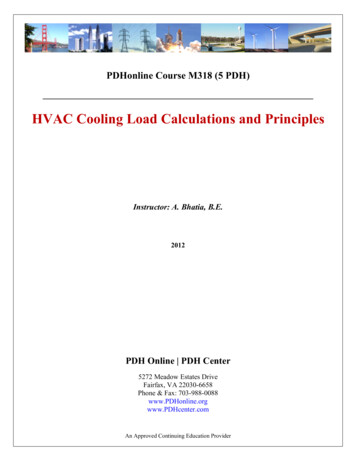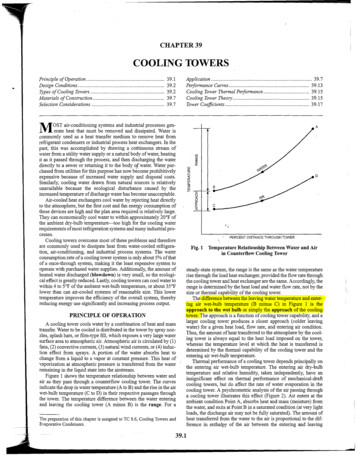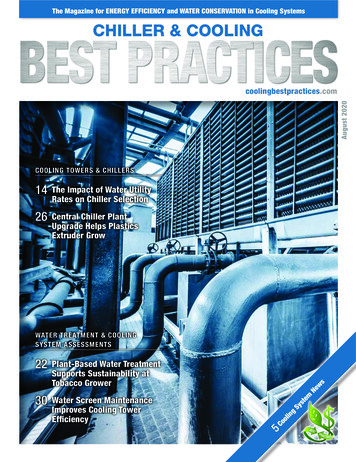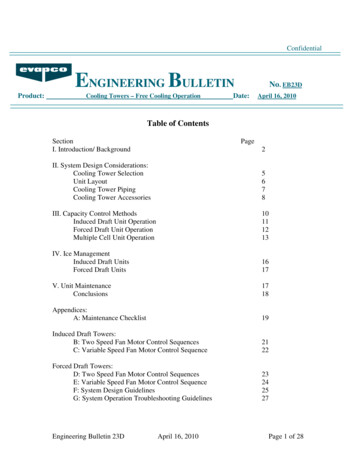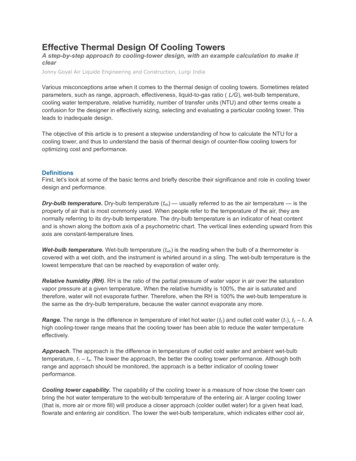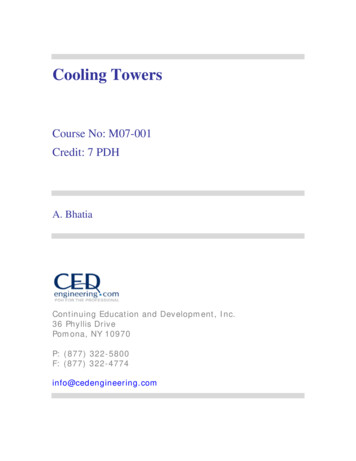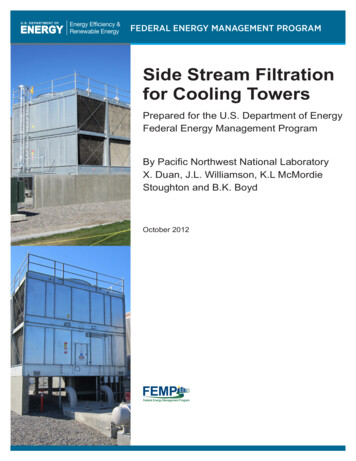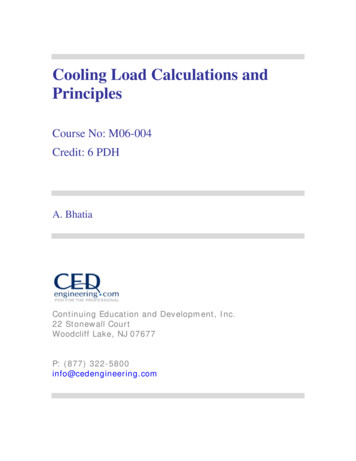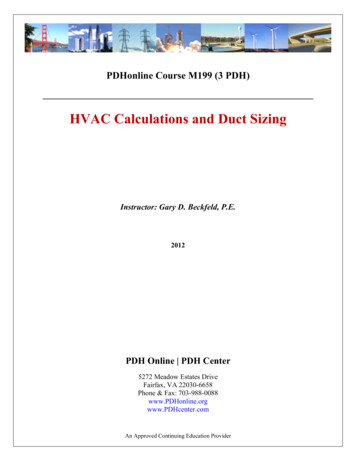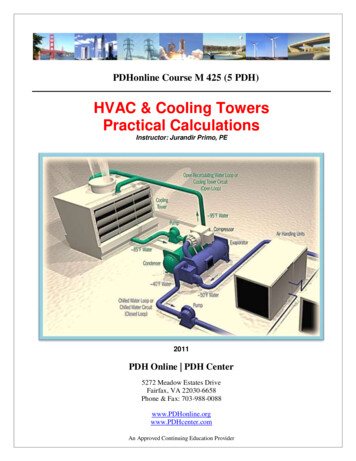
Transcription
PDHonline Course M 425 (5 PDH)HVAC & Cooling TowersPractical CalculationsInstructor: Jurandir Primo, PE2011PDH Online PDH Center5272 Meadow Estates DriveFairfax, VA 22030-6658Phone & Fax: 703-988-0088www.PDHonline.orgwww.PDHcenter.comAn Approved Continuing Education Provider
www.PDHcenter.comPDH Course M 425www.PDHonline.org:CONTENTS1.0 - Heat and Temperature2.0 - Thermodynamics Basic Concepts3.0 – Tons of Refrigeration4.0 – Metabolic Rate5.0 – Comfort Zone6.0 – Heat Transfer7.0 – Dry Bulb Temperature8.0 – Psychrometrics Concepts9.0 – Basic Air Conditioning Calculations10.0 – Heat Loss by Conduction11.0 – Overall Coefficient of Heat Transmission (“U”)12.0 – Heat Loss Calculations13.0 – Heat Conduction and Thermal Resistance14.0 - Heat Loss due Air Change (ACH) and Ventilation15 .0 – Typical Concrete Frames – Thermal Resistance16.0 – Cooling Load Concepts17.0 – CLTD/SCL/CLF - Methods of Load Calculations18.0 – Sizing Ducts19.0 - Temperature Loss in Ducts20.0 – Rules of Thumb for HVAC Calculation21.0 – Chillers & Air Handling Units (AHU)22.0 – Chillers and AH Sizing Rules23.0 – HVAC Refrigerants 2011 Jurandir PrimoPage 2 of 74
www.PDHcenter.comPDH Course M 425www.PDHonline.orgCONTENTS1. Introduction2. Cooling Tower Types3. Components of Cooling Towers4. Cooling Towers Performances5. Factors Affecting Cooling Towers Capacity6. Choosing a Cooling Tower Type7. Water Flow and Heat Transfer8. NTU or KaV/L Calculation9. Consideration of By-Pass Wall Water10. Pressure Drops in Cooling Towers11. Air Flow Arrangements12. Motor Power Sizing13. Water Evaporation14. Determination of Pumping Head 2011 Jurandir PrimoPage 3 of 74
www.PDHcenter.comPDH Course M 425www.PDHonline.orgHVAC – Practical Calculations:HVAC (pronounced either "H-V-A-C" or, occasionally, "H-vak") is an acronym for “Heating, Ventilationand Air Conditioning”. HVAC is referred to climate control as a process of treating air to control itstemperature, humidity, cleanliness and distribution to meet the requirements of the conditioned space.The HVAC industry had been historically regulated by standards organizations such as ASHRAE,SMACNA, ARI, ACCA, Uniform Mechanical Code, International Building Code, and AMCA establishedto support the industry and encourage high standards and achievements.The term ventilation is applied to processes that supply air to or remove air from a space by natural ormechanical means. Such air may or may not be conditioned. An air conditioning system has to handle alarge variety of energy inputs and outputs in and out of the building where it is used.The basic purpose of an HVAC system is to provide interior thermal conditions that a majority ofoccupants will find acceptable. Occasionally this may simply require that air be moved at an adequatevelocity. However, occupant comfort will require that an HVAC system add or remove heat to or frombuilding spaces.1. HEAT AND TEMPERATURE: Heat: Heat may be defined as energy in transit from a high-temperature object to a lower-temperatureobject. This heat transfer may occur by the mechanisms of conduction, convection and radiation. Sensible heat: Kind of heat that increases the temperature of air. It is an expression of the molecularexcitation of a given mass of solid, liquid, or gas. Latent heat: Heat that is present in increased moisture of air. It changes the matter from solid to liquidor from liquid to gas. Heat that is required to change solid to liquid is called latent heat of fusion, and thatwhich is required to change liquid to gas is called latent heat of vaporization. Enthalpy: Sum of sensible and latent heat of a substance e.g. the air in our environment is actually amixture air and water vapor. If the enthalpy of air is known, and the enthalpy of desired comfort conditionis also known, the difference between them is the enthalpy that must be added (by heating orhumidification) or removed (by cooling or dehumidification). Temperature: A measure of the degree of heat intensity. The temperature difference between twopoints indicates a potential for heat to move from the warmer point to the colder point. Unit in Englishsystem is Fahrenheit, and in International System is Celsius. Dry-bulb temperature (DB): The dry-bulb temperature is the temperature of air measured by athermometer freely exposed to the air but shielded from radiation and moisture.More specifically, it is a measure of the intensity of kinetic energy of the molecules in the air. It is one of"the most important climate variables for human comfort and building energy efficiency”. Wet-bulb temperature (WB): The temperature registered by thermometer whose bulb is covered by awetted wick and exposed to a current of rapidly moving air. It is the temperature air would have if part ofits energy were used to evaporate the amount of water it would absorb to become fully saturated. Dew point temperature: The temperature at which condensation begins when the air is cooled. Relative humidity (RH) (actual vapor pressure of air-vapor mixture/pressure of water vapor whenthe air is completely saturated at the same DB temperature) x 100. 2011 Jurandir PrimoPage 4 of 74
www.PDHcenter.comPDH Course M 425www.PDHonline.org Vapor pressure is the pressure exerted by the motion of molecules of water vapor. It is dependent onthe amount of water vapor in the air and the temperature of the air.2. THERMODYNAMICS BASIC CONCEPTS:The biggest problem in thermodynamics is the student to learn and recognize heat, work, force,energy, power and other technical terms. So to facilitate the basic comprehension of the terms it is veryimportant to remember some concepts below:Cal - The “Cal” is the standard unit of measurement for heat. The gram calorie, small calorie or calorie(cal) is the amount of energy required to raise the temperature of one gram of water from 19.5 C to20.5 C under standard atmospheric pressure of 1.033 Kg/cm² (14.7 psi).Btu - British Thermal Unit. The “Btu” is the standard unit of measurement for heat. A Btu is defined asthe amount of energy needed to raise the temperature of one pound of water from 58.5 F to 59.5 Funder standard pressure of 30 inches of mercury (14.7 psi).Energy Unit Conversions:Unit1 604To 0010.001340.000238744.20.0009480.000284To ObtainkWhpkcal/sft.lbf/minBtu/ston (refrig)UnitMultiplyTo 2390.0004231.84186.84.1868778.2ton (refrig)kWhpkgf.m/sft.lbf/skilojoule/kilogram/ C kJ/(kg. C)kilocalorie /kilogram/ C kcal/(kg. C)Btu/pound/ F Btu/(lb. F)Btu/pound/ C Btu/(lb. C)Btu/pound/ C Btu/(lb. C)joule/kilogram/ C J/(kg. C)kilojoule/kilogram/ C kJ/(kg. C)pound-force.foot/pound/ R1Cal1 kcalWatt – is the metric unit for power.1 Btu/s1 joule/kilogram/K J/(kg.K) 1 joule/kilogram/ C J/(kg. C) 1 Btu/pound/ F Btu/(lb F) 2011 Jurandir PrimoPage 5 of 74
www.PDHcenter.comPDH Course M 425www.PDHonline.orgObs.:1 Watt-Hour 0.000948 (Btu/s) x 60 x 60 3.412 Btu/h1 Btu/h 0.293 Watt 0.000293 kWCelsius (also known as centigrade) is a temperature scale that is named after the Swedish astronomerAnders Celsius (1701–1744), who developed a similar temperature scale two years before his death.Then nominally, 0 C was defined as the freezing point of water and 100 C was defined as the boilingpoint of water, both at a pressure of one standard atmosphere (1.033 Kg/cm²).Fahrenheit is the temperature scale proposed in 1724 by, and named after, the physicist Daniel GabrielFahrenheit (1686–1736). On the Fahrenheit scale, the freezing point of water was 32 degreesFahrenheit ( F) and the boiling point 212 F at standard atmospheric pressure (14.7 psi).Pressure (P) is the force per unit area applied in a direction perpendicular to the surface of an object.Gauge pressure is the pressure relative to the local atmospheric or ambient (Torr)pound-force persquare inch(psi)1 Pa1 N/m²0.000010.0000098670.00750060.0001451 bar100000106 dyn/cm²0.986775014.51 at980660.9806650.968735.514.2231 atm1013251.013251 atm76014.71 torr133.3220.0133320.00131581 mmHg0.01931 psi0.0068940.0689480.06804651.721 lbf/in²3. TONS OF REFRIGERATION:For commercial and industrial refrigeration systems most of the world uses the kilowatt (kW) as thebasic unit refrigeration. Typically, commercial and industrial refrigeration systems are rated in Tons ofRefrigeration (TR).One Ton of Refrigeration was defined as the energy removal rate that will freeze 1 ton of water at 0 C(32 F) in one day, or, the amount of heat required to melt 1 ton of ice in 24 hours. The unit's value isapproximately 11,958 Btu/h (3.505 kW), redefined to be exactly:1 Ton of Refrigeration 12,000 Btu/h (3.517 kW) 3,024 Kcal/h4. METABOLIC RATE:Metabolic rate is measured in Met units. A Met is the average amount of heat produced by a sedentaryperson (e.g. office work 1 Met).1 Met unit corresponds approximately: 360 Btu/h 90,718 cal/h 90.718 kcal/h.Human beings are essentially constant-temperature creatures with a normal internal body temperatureof 98.6 F. Heat is produced in the body as result of metabolic activity. 2011 Jurandir PrimoPage 6 of 74
www.PDHcenter.comPDH Course M 425www.PDHonline.orgIf the internal temperature rises or falls beyond its normal range, mental and physical operation isjeopardized or affected, and if the temperature deviation is extreme, then serious physiological disordersor even death can result.5. COMFORT ZONE:The comfort range of temperature during summer varies between 70 to 76 F dry bulb temperaturesand 45 - 65% relative humidity.The comfort range during cold winters would be in the range of 65 to 68 F dry bulb temperature andrelative humidity of a minimum of 30%.6. HEAT TRANSFER:Conduction: is the spontaneous transfer of thermal energy through matter, from higher temperature tolower temperature, and acts to equalize temperature differences. It is also described as heat energytransferred from one material to another by direct contact.Convection: is usually the dominant form of heat transfer in liquids and gases. Convection is circulationof a fluid or gas/air caused by temperature difference. Commonly an increase in temperature produces areduction in density.Evaporation: It is exclusively a cooling mechanism. Evaporative losses become a predominant factorwhen ambient temperatures are very high. When surrounding temperature is about 70 F, most peoplelose sensible heat.Radiation: is the only form of heat transfer that can occur in the absence of any form of medium; itmeans heat transfers through a vacuum. Thermal radiation is a direct result of the movements of atomsand molecules in a material.7. DRY BULB TEMPERATURE:Thermal Comfort zone: It is an area plotted on the psychrometric chart. During summer the comfortrange of temperature varies between 70 to 76 F dry bulb temperatures, that is, 45 - 65% RH.During cold winters the comfort condition would be in the range of 65 to 68 F dry bulb temperature andrelative humidity of a minimum of 30%.Humidity: Density of water vapor per unit volume of air is expressed in units of lbs. of water/ft³ of dryair. Specific humidity weight of water vapor per unit weight of dry air, expressed in grains/lb.Relative Humidity (RH): Human tolerance to humidity variations: in winter is from 20 to 50%; insummer, the range extends up to 60% @ 75ºF. High humidity causes condensation problems andreduces body heat loss by evaporative cooling.8. PSYCHROMETRICS CONCEPTS:Psychrometrics or psychrometry are terms used to describe the field of engineering concerned withthe determination of physical and thermodynamic properties of gas-vapor mixtures.The term derives from the Greek psuchronmeasurement". 2011 Jurandir Primomeaning "cold" and metron meaning "means ofPage 7 of 74
www.PDHcenter.comPDH Course M 425www.PDHonline.orgThermodynamic properties of moist air are affected by atmospheric pressure. The standard temperatureis 59 F and standard atmospheric pressure is 29.921 in-Hg (14.697 psi) at sea level.The apparent molecular mass or weighted average molecular weight of all components, for dry air is28.9645, based on the carbon-12 scale.The gas constant for water vapor is 1545.32/18.01528 85.778 ft-lb/lb R. The temperature andbarometric pressure of atmospheric air vary with altitude as well as with local geographic and weatherconditions.Gravity is also assumed constant at the standard value, 32.1740 ft/s2.a) Psychrometric chart:A psychrometric chart is a graphical presentation of the thermodynamic properties of moist air andvarious air-conditioning processes and air-conditioning cycles.The most common chart is the temperature - humidity ratio (w) chart. The Dry Bulb Temperature(DB) appears horizontally as the abscissa and the humidity ratios (w) appear as the vertical axis.Abridged sample of psychrometric chart is shown below:b) How to Read a Psychrometric Chart: Dry bulb temperature (DB): Verticals lines designate DB. A standard psychrometric chart for airconditioning applications has a temperature range of 32 to 120 F. Wet bulb temperature (WB): Diagonals lines rising upward from left to right having negative slopeslightly greater than that of the h-lines. A wet bulb line meets the DB line of the same magnitude on thesaturation curve representing 100% RH. 2011 Jurandir PrimoPage 8 of 74
www.PDHcenter.comPDH Course M 425www.PDHonline.org Dew point temperature (DP): Follow the horizontal line from the point where the line from thehorizontal axis arrives at 100% RH, also known as the saturation curve. On a saturation curve the drybulb, wet bulb and dew point temperature (DP) have the same value. Relative humidity (RH%): Curved lines that radiate from lower left to upper right are RH lines.Horizontal line at the bottom represents 0% RH; the uppermost curved line is 100% RH line. Humidity ratio: Humidity ratio or
17.0 – CLTD/SCL/CLF - Methods of Load Calculations 18.0 – Sizing Ducts 19.0 - Temperature Loss in Ducts 20.0 – Rules of Thumb for HVAC Calculation 21.0 – Chillers & Air Handling Units (AHU) 22.0 – Chillers and AH Sizing Rules 23.0 – HVAC Refrigerants . www.PDHcenter.com PDH Course M 425 www.PDHonline.org 2011 Jurandir Primo Page 3 of 74 CONTENTS 1. Introduction 2. Cooling Tower .
